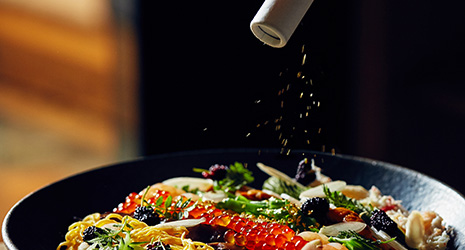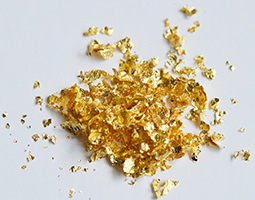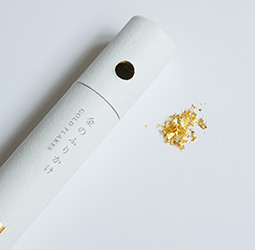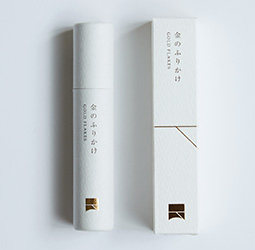March 2023
- English
- 日本語
Gold Flakes

Gold Flakes sprinkled on food or drinks create a sense of omotenashi hospitality 
Gold Flakes float on a small cup of sake

Magnified image of Gold Flakes 
Gold Flakes are released by turning the cap of the tube and shaking 
A tube of Gold Flakes (11 cm x 2 cm) and box

Kin no Furikake,* or Gold Flakes, a product made using high purity gold leaf, has been gaining popularity in Japan as a way to add a touch of omotenashi hospitality to special occasions.

“Often, the faces of guests light up when they see our gold leaf being sprinkled from a tube in front of them onto their food or drink,” says Fujii Ikuyo of Rekiseisha Co., Ltd. in Hiroshima City, Hiroshima Prefecture.
Kin no Furikake, a product known in English as “Gold Flakes,” has been gaining in popularity in recent years. Fine pieces of gold leaf are released from a small hole by turning the cap of a long, slender cardboard tube and giving it a gentle shake. In Japan, gold leaf has long been used to bring an element of glamour to dishes, sake, sushi, sweets, and other foods served on celebratory occasions. Based on this cultural practice, the company developed the product Gold Flakes.

Fujii explains, “We believe that gold has the power to make people smile and so spread happiness all over the world. We developed Gold Flakes to make gold more accessible so that more people can experience that happiness.” Gold passes through the human body without being digested, so consuming it in small amounts does not pose a health hazard, and the Japanese government has authorized its use as a food additive.
The pursuit of luxury is at the heart of Rekiseisha’s Gold Flakes, which are made from high purity gold leaf with no use of copper. The company was originally a folding screen merchant, and in 1905 it succeeded in developing gold paper using Western gold leaf (brass foil) that did not tarnish easily and could withstand practical use. The company continues to produce a range of items applying the time-honored technique of hakuoshi (gilding) that has been passed down through the generations.

Hakuoshi is the technique of applying extremely thin 0.0001 millimeter sheets of gold or silver leaf to paper. The technique has been used since antiquity in Shinto shrine and Buddhist temple architecture, as well as on folding screens and fusuma paper panels used for decorative purposes or as room partitions.
Gold Flakes for use in food and drink are a novel application that has made the traditional haku culture more accessible to the general public. Gold Flakes are packaged in a handy cardboard tube 11 centimeters long and 2 centimeters in diameter. They are used to create a sense of occasion, such as by sprinkling in champagne or wine when making a toast, and are a very popular gift. Gold Flakes won a Japan Institute of Design Promotion Good Design award in 2019.

Recent years have seen a trend among young Japanese women to apply gold leaf to their hair when dressing up to attend a coming-of-age ceremony or party. Using Gold Flakes is a simple way to give hair sparkle and create an impression of gorgeousness. Says Fujii, “The technique of processing precious gold into extremely thin sheets developed in Japan. I feel that young women can now also readily enjoy the delicate beauty of Gold Flakes.”
Rekiseisha makes a range of items using hakuoshi paper such as postcards, sketchbooks, and brooches. It seeks to promote haku products that add a touch of brilliance to people’s everyday lives.
* Furikake is a Japanese condiment in powdered or crumbled form sprinkled mainly on cooked rice.

